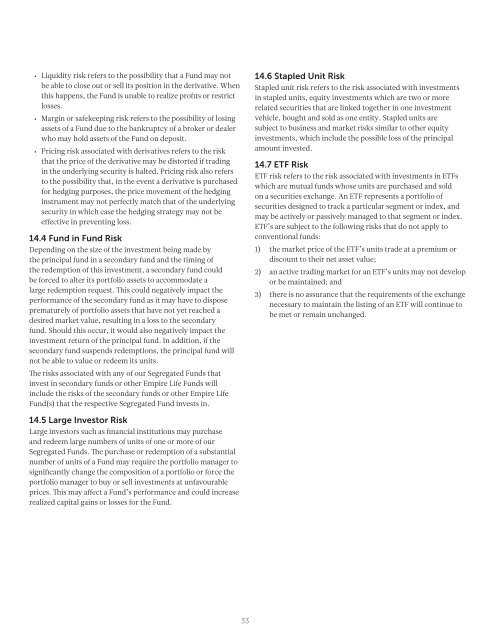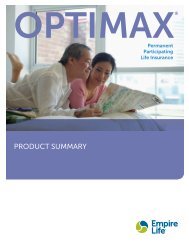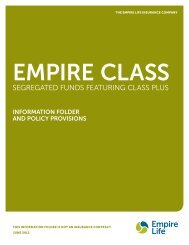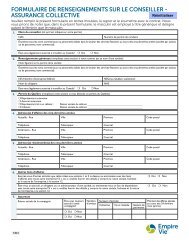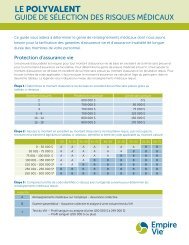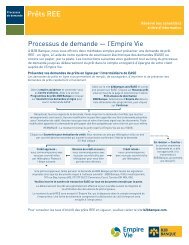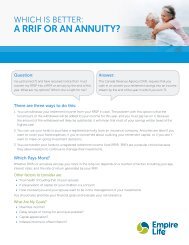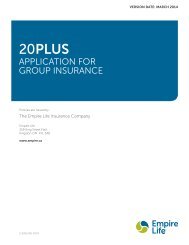Class Plus 2 Information Folder and Contract Provisions - Empire Life
Class Plus 2 Information Folder and Contract Provisions - Empire Life
Class Plus 2 Information Folder and Contract Provisions - Empire Life
- No tags were found...
You also want an ePaper? Increase the reach of your titles
YUMPU automatically turns print PDFs into web optimized ePapers that Google loves.
• Liquidity risk refers to the possibility that a Fund may notbe able to close out or sell its position in the derivative. Whenthis happens, the Fund is unable to realize profits or restrictlosses.• Margin or safekeeping risk refers to the possibility of losingassets of a Fund due to the bankruptcy of a broker or dealerwho may hold assets of the Fund on deposit.• Pricing risk associated with derivatives refers to the riskthat the price of the derivative may be distorted if tradingin the underlying security is halted. Pricing risk also refersto the possibility that, in the event a derivative is purchasedfor hedging purposes, the price movement of the hedginginstrument may not perfectly match that of the underlyingsecurity in which case the hedging strategy may not beeffective in preventing loss.14.4 Fund in Fund RiskDepending on the size of the investment being made bythe principal fund in a secondary fund <strong>and</strong> the timing ofthe redemption of this investment, a secondary fund couldbe forced to alter its portfolio assets to accommodate alarge redemption request. This could negatively impact theperformance of the secondary fund as it may have to disposeprematurely of portfolio assets that have not yet reached adesired market value, resulting in a loss to the secondaryfund. Should this occur, it would also negatively impact theinvestment return of the principal fund. In addition, if thesecondary fund suspends redemptions, the principal fund willnot be able to value or redeem its units.The risks associated with any of our Segregated Funds thatinvest in secondary funds or other <strong>Empire</strong> <strong>Life</strong> Funds willinclude the risks of the secondary funds or other <strong>Empire</strong> <strong>Life</strong>Fund(s) that the respective Segregated Fund invests in.14.6 Stapled Unit RiskStapled unit risk refers to the risk associated with investmentsin stapled units, equity investments which are two or morerelated securities that are linked together in one investmentvehicle, bought <strong>and</strong> sold as one entity. Stapled units aresubject to business <strong>and</strong> market risks similar to other equityinvestments, which include the possible loss of the principalamount invested.14.7 ETF RiskETF risk refers to the risk associated with investments in ETFswhich are mutual funds whose units are purchased <strong>and</strong> soldon a securities exchange. An ETF represents a portfolio ofsecurities designed to track a particular segment or index, <strong>and</strong>may be actively or passively managed to that segment or index.ETF’s are subject to the following risks that do not apply toconventional funds:1) the market price of the ETF’s units trade at a premium ordiscount to their net asset value;2) an active trading market for an ETF’s units may not developor be maintained; <strong>and</strong>3) there is no assurance that the requirements of the exchangenecessary to maintain the listing of an ETF will continue tobe met or remain unchanged.14.5 Large Investor RiskLarge investors such as financial institutions may purchase<strong>and</strong> redeem large numbers of units of one or more of ourSegregated Funds. The purchase or redemption of a substantialnumber of units of a Fund may require the portfolio manager tosignificantly change the composition of a portfolio or force theportfolio manager to buy or sell investments at unfavourableprices. This may affect a Fund’s performance <strong>and</strong> could increaserealized capital gains or losses for the Fund.33


